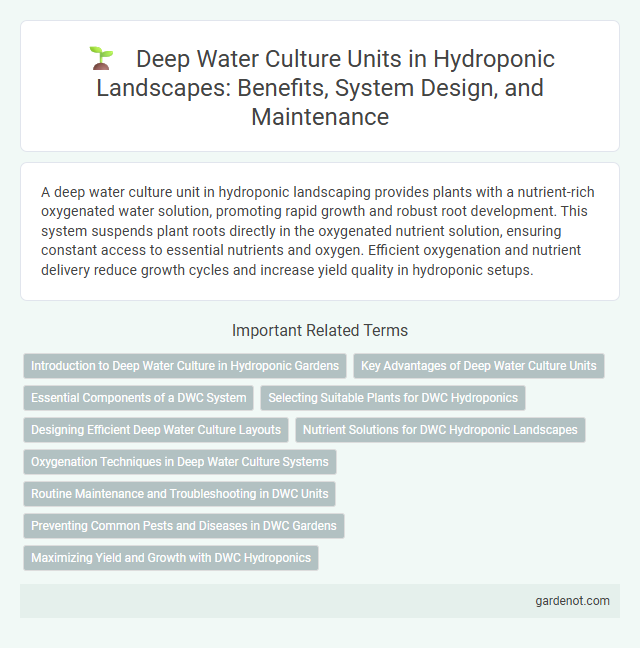A deep water culture unit in hydroponic landscaping provides plants with a nutrient-rich oxygenated water solution, promoting rapid growth and robust root development. This system suspends plant roots directly in the oxygenated nutrient solution, ensuring constant access to essential nutrients and oxygen. Efficient oxygenation and nutrient delivery reduce growth cycles and increase yield quality in hydroponic setups.
Introduction to Deep Water Culture in Hydroponic Gardens
Deep Water Culture (DWC) is a hydroponic technique where plant roots are suspended in oxygen-rich nutrient solutions, promoting rapid growth and maximizing nutrient uptake. This system relies on an air pump to oxygenate the water, preventing root rot and enhancing plant health. Ideal for leafy greens and herbs, DWC units offer a space-efficient and soil-free method for sustainable hydroponic gardening.
Key Advantages of Deep Water Culture Units
Deep water culture units provide rapid plant growth by delivering constant oxygen and nutrient-rich water directly to roots, enhancing nutrient absorption efficiency. Their simple design reduces maintenance time and minimizes disease risks compared to traditional soil methods. This system optimizes water and nutrient use, making it highly sustainable and effective for large-scale hydroponic operations.
Essential Components of a DWC System
A Deep Water Culture (DWC) system relies on essential components such as an aeration pump, air stones, and a nutrient-rich water reservoir to maintain optimal oxygen levels for plant roots submerged in nutrient solutions. The net pots support plant growth while allowing roots to dangle directly into the oxygenated water bath, promoting rapid nutrient uptake. Effective DWC units also incorporate a water-tight container to prevent contamination and maintain stable pH and temperature conditions critical for hydroponic plant health.
Selecting Suitable Plants for DWC Hydroponics
Selecting suitable plants for Deep Water Culture (DWC) hydroponics involves prioritizing species with lightweight root systems and rapid oxygen absorption, such as lettuce, spinach, and herbs like basil and mint. These plants thrive in the nutrient-rich, oxygenated environment provided by DWC units, ensuring optimal growth rates and minimal root rot risk. Choosing plants suited for DWC enhances nutrient uptake efficiency and overall system productivity.
Designing Efficient Deep Water Culture Layouts
Designing efficient Deep Water Culture (DWC) layouts requires optimizing aeration systems to ensure adequate dissolved oxygen levels for plant roots, which enhances nutrient uptake and growth. Strategic placement of air stones and water pumps minimizes energy use while maximizing oxygen distribution across plant channels. Utilizing modular raft designs allows scalable and flexible DWC systems suitable for various crop types and spatial constraints in hydroponic landscapes.
Nutrient Solutions for DWC Hydroponic Landscapes
Nutrient solutions for Deep Water Culture (DWC) hydroponic landscapes require precise balancing of macro and micronutrients to promote optimal plant growth and root development. Maintaining an ideal pH range between 5.5 and 6.5 and dissolved oxygen levels above 6 mg/L ensures nutrient availability and prevents root diseases in the DWC system. Regular monitoring and adjustment of electrical conductivity (EC) between 1.2 to 2.0 mS/cm optimize nutrient uptake efficiency, enhancing the vitality of hydroponic plants in the aquatic environment.
Oxygenation Techniques in Deep Water Culture Systems
Deep Water Culture (DWC) systems rely on effective oxygenation techniques to maintain optimal dissolved oxygen levels essential for root respiration and nutrient uptake. Aeration methods include using air stones connected to air pumps, which create fine bubbles that increase oxygen diffusion in the nutrient solution, preventing root hypoxia. Advanced approaches incorporate oxygen concentrators or pure oxygen injection to enhance oxygen availability, promoting faster plant growth and higher yields in hydroponic landscapes.
Routine Maintenance and Troubleshooting in DWC Units
Routine maintenance of Deep Water Culture (DWC) units involves regularly checking and adjusting the pH levels, cleaning air stones to ensure proper oxygenation, and monitoring water temperature to prevent root stress. Troubleshooting common issues includes addressing root rot by improving aeration, resolving nutrient deficiencies through balanced hydroponic nutrient solutions, and preventing algae growth by minimizing light exposure to the nutrient reservoir. Consistent inspection of pumps, air stones, and reservoir cleanliness is critical for optimal plant growth in hydroponic landscapes using DWC systems.
Preventing Common Pests and Diseases in DWC Gardens
In Deep Water Culture (DWC) units, maintaining water quality and oxygen levels is critical to prevent common pests such as root aphids and diseases like Pythium root rot. Regular monitoring for signs of infestation, coupled with biocontrol agents like beneficial nematodes and microbial inoculants, helps reduce pest populations effectively. Implementing sterile practices and ensuring proper nutrient balance further minimize disease outbreaks, promoting healthy root development in hydroponic landscapes.
Maximizing Yield and Growth with DWC Hydroponics
Deep water culture (DWC) hydroponics maximizes yield by providing plants with continuous access to oxygen-rich nutrient solutions, promoting faster growth and higher productivity. By suspending roots directly in oxygenated water, DWC units enhance nutrient absorption efficiency and reduce transplant shock, resulting in healthier, more vigorous plants. Optimizing parameters such as dissolved oxygen levels, pH balance, and temperature in DWC systems ensures consistent crop performance and maximized biomass output.
Deep water culture unit Infographic

 gardenot.com
gardenot.com